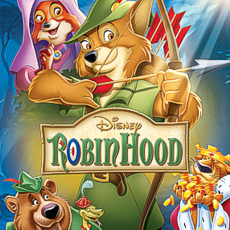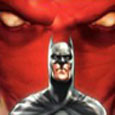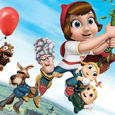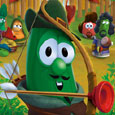Walt Disney Productions (November 8, 1973), Walt Disney Home Entertainment (November 28, 2006), 1 disc set, 83 mins plus supplements, 1.75:1 “enhanced” widescreen ratio, English (Dolby Digital 5.1), French (Dolby Digital 2.0), Spanish (Dolby Digital 2.0), Rated G, Retail: $29.99
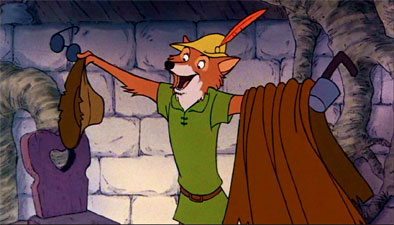
Storyboard:
Disney’s Robin Hood follows the traditional story of the famed English hero, but with all of the main characters portrayed as animals. It begins with a rooster balladeer named Allan-a-dale who appears throughout the movie narrating the story of Robin Hood. When we first meet Robin and his partner-in-crime Little John, they are running through the forest trying to get away from the Sheriff of Nottingham and his men. This quickly establishes them as outlaws and we see them commit their first crime when they steal gold from a royal caravan, which is transporting Prince John and his adviser Sir Hiss to Nottingham. The main characters are quickly established with Robin Hood and Little John as masters of disguise and Prince John as wanting to usurp the throne from his brother King Richard who is off fighting in the Great Crusades.

However, we soon learn that Robin is no common thief when, back in Nottingham, the Friar Tuck delivers the gold Robin stole back to the poor. The local Sheriff of Nottingham is collecting taxes and we learn that Prince John is heavily taxing his own people for personal gain. This is when we meet a group of local children who admire Robin Hood. During one of their games, they end up accidentally entering Prince John’s castle grounds where they meet the lovely Maid Marian who is playing badminton with her lady-in-waiting Lady Kluck. The children sneak in, and we find out that Maid Marian was once Robin Hood’s sweetheart and that she has not seen him for many years. Throughout the movie, Prince John grows increasingly obsessed with capturing Robin Hood and he uses both Maid Marian and the townspeople as bait for his schemes. The first part of the movie establishes the characters and deals with Robin and his quest to gain Maid Marian’s hand. The second part is about Prince John enacting his revenge on Robin Hood by sentencing Friar Tuck to his death and by imprisoning the people of Nottingham, forcing Robin Hood to save them.
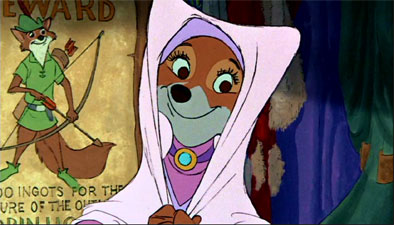
The Sweatbox Review:
Disney’s Robin Hood is one of the first Disney movies I remember watching as a child. My father had been traveling and when he returned, he brought with him three Disney cartoons on tape, one of which was Robin Hood. Today, like with many others of my favorite cartoons, I can recite every word and I know every moment of the movie. It could be that the animals in Robin Hood are just fun to watch, or that his adventures are pure entertainment, but there is just something about it that makes it memorable. The story is one of England’s oldest legends and has produced several cinematic versions. Perhaps the most famous portrayal of the popular hero is Errol Flynn’s in 1935’s The Adventures of Robin Hood. With adventure, romance, danger, and humor, Disney’s version has something to offer to people of all ages and is just as enjoyable years after its first viewing.
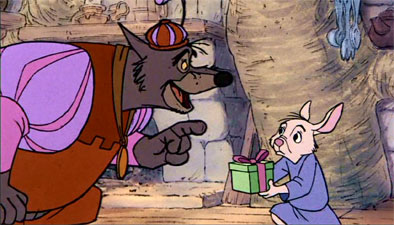
Robin Hood is known around the world as the legendary British thief who stole from the rich and gave to the poor. History identifies him as a nobleman who was lowered in rank by Prince John while King Richard was fighting in the Holy Crusades. Defying the prince, Robin began to steal from the royalty to give back to the poor who were starving due to unfair tax laws. He successfully battled the prince and gained prominence throughout England as a symbol of hope. Later, he would supposedly regain his title when King Richard returned from the Crusades. Legend also has it that Robin Hood was not alone and that he was surrounded by his band of “merry” men who helped him in his exploits. The most notable of these characters include “Little” John and a friar named Tuck. The legend also grew over the years to include a love interest called Maid Marian who was a noble woman under the care of the Prince.
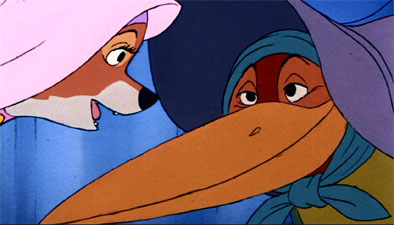
In 1973, the Walt Disney Company was still trying to re-establish itself as the animation powerhouse that it once was with Walt Disney. Although The Aristocats had been a box-office success, many began feeling that something special was missing without Walt’s touch. Critics were not unhappy with the animation, but they felt that the company was not being as original as they had been in the past with some of their classics. With Robin Hood, the company hoped to achieve another great success with another timeless adventure story. When the movie finally came out in 1973, it became Disney’s biggest animated hit to date. Although critics initially claimed the cartoon was unoriginal and unmemorable (many citing Disney’s 1952 live action film The Story of Robin Hood and His Merrie Men as being a superior film), it has stood the test of time to become one of the company’s most memorable films from the 70s
The main difference in this Disney feature is that the characters are all depicted as different forest animals. Both Robin Hood and Maid Marian are foxes, Little John is a bear, Prince John and King Richard are lions, and Friar Tuck is a large badger. Other animals rounding up the cast include snakes, rabbits, chickens, roosters, turtles, alligators, vultures, elephants, rhinos, dogs, and wolves. While most families remain within the same species (such as the rabbit family), not all of the relationships make sense. For example, Maid Marian, a vixen, is the King Richard’s, a lion’s, niece. All of the animals live in the city of Nottingham where Prince John is passing by on a tour of the countryside. Robin Hood, in turn, hides out in Sherwood Forest with his best friend Little John and his band of merry men. Most of the time they are trying to find new ways to steal from the nobility, or running away from the law, but when Prince John comes to town, bringing Maid Marian, things change.
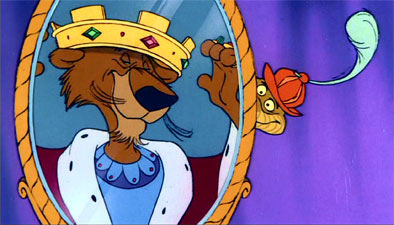
While I love Robin Hood, I do believe that it is a structurally weak film. By splitting the plot into two discernible parts, the movie plays out like two episodes of a television show instead of a whole movie. Maid Marian does not even appear in the second part of the movie, even though she is a focal point in the first half. The other major problem in the movie is that Robin Hood himself is not as interesting as the other characters. When remembering the characters in the movie, the villains and other supporting characters are the ones that stand out the most. One wants to see more of Prince John, Maid Marian, and Little John, or even Allan-a-dale. That is not to say that Robin Hood is not a good character, just not a very interesting one. He is limited by his own heroic nature and there’s not much else to his character. When I think of Disney heroes, Robin doesn’t even make the top ten. Perhaps by being one of the few adult Disney heroes, he cannot portray the youthfulness that made Peter Pan and Pinocchio so engaging.
Still, he is a good hero and actor Brian Bedford adds some charm to the character with his voice. Other voices include Academy Award winning actor Peter Ustinov as Prince John and King Richard, Terry Thomas as Sir Hiss, and Monica Evans as Maid Marian. While a traditionally British story, many of the voice actors are actually American, and there is particular American western element found in characters such as The Sheriff of Nottingham and Friar Tuck. Roger Miller (Alan-a-Dale), the film’s narrator, was also a popular country star in the 60’s, which only reinforces the western feel of the movie. Phil Harris, who had previously worked as Baloo in The Jungle Book, and as J. Thomas O’Malley in The Aristocats, plays a similar character as Little John. Other Aristocats veterans also appear such Pat Buttram, George Lindsey, and Carole Shelley.
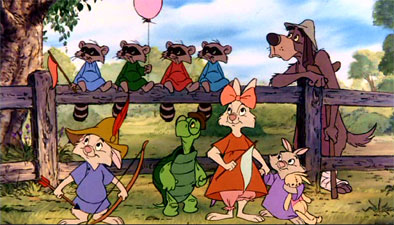
Is This Thing Loaded?
This is basically an update of the previous Gold Collection release, and there are only a handful of special features included in the disc. The Gold Collection DVD included a storybook narrating the story of Robin Hood for kids, an interactive trivia game about the movie and its characters, a sing-along video for “Oo-de-lally”, and the 1933 Ye Olden Days Mickey Mouse cartoon. The new version does not include the storybook, but there are two new games, and a sing-along version for most songs. The new games include an Archery Trivia Challenge where you have to answer questions as fast as possible to aim correctly and win points. The second game is the Rescue Maid Marian game where you search for 6 items in 4 background scenes to rescue Maid Marian. The Ye Olden Days cartoon is a cute short set in old England about the same time as Robin Hood with Mickey, Minnie, and Dippy Dawg (an early version of Goofy). The new edition includes sing-along versions for “Love” and “The Phony King of England” in addition to “Oo-de-lally.” I was surprised one of my favorite songs, “Not in Nottingham” was not included, but that is the nature of DVDs I suppose.

In addition to all the features in the Gold Collection, this new “Most Wanted” Edition includes a deleted scene, and an art gallery. The deleted scene takes place after Robin Hood jumps off the tower at the end of the movie, but in this version he gets hurt. Prince John follows him to the church where he attempts to kill Robin when King Richard unexpectedly appears to stop him. I like the ending, and while it might have dragged the movie on for longer than needed, it is at least nice to see Maid Marian play a role in the end of the movie. The art gallery features two viewing options with viewers being able to choose between browsing through the art gallery and listening to a narrated tour (8:51) of the art gallery. I really enjoyed the commentaries on the different pictures and the narrator talks a little about some of the pre-production of the movie. This is as close as we get to a featurette on this DVD. Could we have had a more in-depth look at the making of the movie? Sure, but like I said, this is basically a Gold Collection re-release.
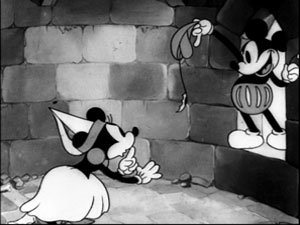
Rounding out the special features are the trailers to recent Disney releases: Cinderella III (no comment), Enchanted Tales: A Kingdom of Kindness (I makes sense financially, but why???), My Friends: Tigger and Pooh (the new CGI Winnie the Pooh actually looks cool), Little Einsteins: The Legend of the Golden Pyramid, Peter Pan: Special Edition, Meet the Robinsons, The Fox and the Hound, and Air Buddies (this is still around?).

Case Study:
This one-disc set comes in a standard black keep case with the locking mechanism that I suppose is to keep kids away. The case is covered with a cardboard slipcase featuring the same artwork as the one found on the cover. Inside the case are two sheets (so nice when they do this), one with the features and scene selections on one side and an ad for The Cheetah Girls 2 movie on the other, and a second sheet promoting the Disney Movie Rewards program. As for the artwork, I really liked the art on the cover, although the characters look a bit rounder and polished than the ones featured in the movie.
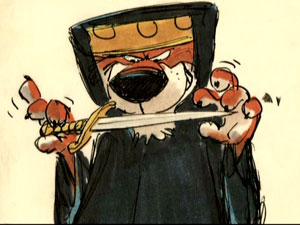
Ink And Paint:
The first thing that I noticed when I popped this DVD into my DVD player was that everything was in widescreen. At first I thought nothing of widescreen trailers or menus, because they have become standard in the industry with more and more people switching to 16 x 9 televisions. Then, the movie started. When I saw the first images on Robin Hood on the screen, I was surprised. The movie is presented in an “enhanced” 1.75:1 aspect ratio with quite a bit cut from the top and the bottom. Call me a purist, but is there really a huge demand for studios to chop up original animation so a movie can fit on 16 x 9 televisions? It brought back memories of the days when everything was being released in fullscreen when they were supposed to be in widescreen. What’s next, Snow White in Cinemascope? To be fair, while Robin Hood’s original negatives are in 1.37:1, the aspect ratio was intended to be 1.75:1 when it originally played in theatres. Still, I just wish that Disney had given viewers an option. Purists that own the Gold Collection release may want to hold on to their old copies based on this alone.
The animation style in Robin Hood is very much reminiscent of other features from the seventies with many pencil lines still visible. It is fascinating to notice little animation details throughout the movie that keep changing such as the number of rings in Prince John’s hands, and some hidden Mickey Mouse heads. Supposedly, this is a new digital transfer, but the first release only had minor amounts of dust and scratches on the negative. The image is a little bit better, with some brighter colors here and there, but I will leave it up to you guys to decide on this one. I was too distracted by the aspect ratio to notice anything else.
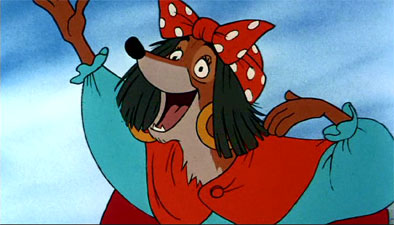
Scratch Tracks:
One of my primary concerns with the previous Gold Collection release was the simple mono track used in that particular release. Now, we finally get an upgrade to Dolby Digital 5.1 Surround Sound (French and Spanish tracks are in 2.0). With the great sound effects found on this cartoon, I am glad that they at least got the sound right.
Of course, like many Disney movies, this one comes loaded with some great songs. There are several memorable songs from the movie, and the song “Love” was even nominated for the Academy Award in its day. Since the troubadour Alan-a-Dale, voiced by Roger Miller, is narrating part of the story, he sings many of the songs throughout the movie. “Oo-de-lally” is the first song, and it is a catchy song that plays while Robin and Little John are being chased through the forest. To me, the most memorable is the song “Not in Nottingham” about the sadness in the town when the people are taxed and jailed. “Love”, sung by Nancy Adams, is a beautiful ballad sung while Robin and Maid Marian are walking through the forest. All songs are fun, and catchy, enhancing the experience of watching this film.

Final Cut:
Despite its flaws, Robin Hood continues to be an entertaining Disney feature that has withstood the test of time. It is one of the finest pure adventure movies that Disney has made, and the movie is filled with wit and charm. The new “Most Wanted” edition does add a couple of new bonus features and a new digital transfer. When I first watched the Gold Collection release, my main problem was with the mono sound track, which has been pleasantly upgraded here to 5.1. We also get a nice bonus feature with the deleted scene. Still, that’s where my praise ends for this release. I am upset that Disney decided to crop the original aspect ratio on this one. Fans who own a copy of the previous edition may just want to hold on to their copies, while big fans might want to double-dip just for the new sound and visual transfers. For those that do not own the first DVD release, please do not let this spoil the movie for you. I will let you decide if you care this is cropped, but I will remind you that you can find copies of the Gold Collection version on sale as well. This edition, however, does not completely disappoint since the movie is one of the most charming produced in the seventies. It is entertaining for children of all ages, and it still has something to teach us about morals and justice.
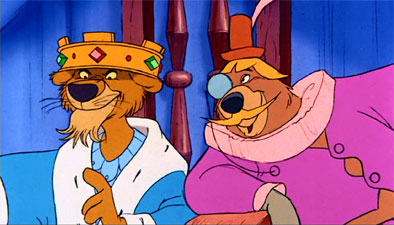
 | ||
 |






